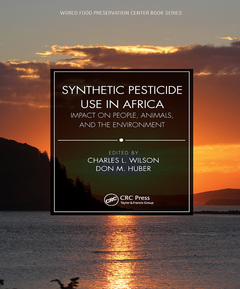Synthetic Pesticide Use in Africa Impact on People, Animals, and the Environment World Food Preservation Center Book Series
Coordonnateurs : Wilson Charles L., Huber Don M.

A UN report presented to the UN Human Rights Council in 2017 recognized that, ?although pesticide use has been correlated with a rise in food production, it has had catastrophic impacts" on human health and the environment. The report acknowledged that ?increased food production has not succeeded in eliminating hunger worldwide because of the many interacting factors involved. Reliance on hazardous pesticides is a short-term solution that undermines the rights to adequate food and health for present and future generations."
It is hoped that the knowledge available in Synthetic Pesticide Use in Africa: Impact on People, Animals, and the Environment will both enlighten the reader to present serious concerns on the use of synthetic pesticides, and motivate society to make the changes necessary for the sustainable production of safe, nutritious, and affordable food for the anticipated 9.6 billion inhabitants of this Earth in 2050.
Key Features:
? Explains the relationship of synthetic pesticides to escalating noncommunicable human and animal diseases in Africa and developing countries.
? Discusses the impact of the herbicide glyphosate on the health of humans, animals, and the environment.
? Reviews the disease causing mode of action of glyphosate and other synthetic pesticides on nutrient density and human and animal bodies.
? Warns of the special vulnerability of children to synthetic pesticide toxicity.
? Recommends needed legal initiatives to use synthetic pesticides more judiciously.
The book is divided into seven (7) sections: I. General Impact, explains the general impact of synthetic pesticides on the African people, their animals, and environment. II. Human Health, covers the impact of synthetic pesticides on the human body, while III, Children?s Health, focuses on the special vulnerability of children to synthetic pesticides. IV. Animal Health describes the synthetic pesticide threats to animal production and sustainability. V. Environmental Health presents the threat of synthetic pesticides to soil microbiota and sustainable remediations. VI. Control Strategies discusses biologically-based alternatives to synthetic pesticides. Finally, VII. Reglatory Control presents some legal initiatives to combat the misuse of synthetic pesticides.
Contents
Preface..............................................................................................................................................vii
Editors................................................................................................................................................ix
Contributors.......................................................................................................................................xi
Chapter 1 Impact of Synthetic Pesticides on the Health of the African People,
Animals and Environment............................................................................................1
Peter Mokaya
Chapter 2 Glyphosate’s Impact on Humans, Animals, and the Environment...............................7
Don M. Huber
Chapter 3 Health, Nutrition, and Sustainability: Precious Commodities in
Jeopardy from Agricultural Pesticides........................................................................ 21
Arden Andersen
Chapter 4 Agricultural Pesticides and the Deterioration of Health............................................. 33
Stephanie Seneff
Chapter 5 Synthetic Pesticides and the Brain.............................................................................. 43
Prahlad K. Seth and Vinay K. Khanna
Chapter 6 Insufficient Evidence for Pesticide Safety................................................................... 61
Andre Leu
Chapter 7 Pesticides and the Crisis in Children’s Health............................................................ 71
Michelle Perro
Chapter 8 Animal Health Issues with Increased Risk from Exposure to
Glyphosate-Based Herbicides.....................................................................................83
Arthur Dunham
Chapter 9 Agricultural Pesticide Threats to Animal Production and Sustainability................ 129
Dr. Ted Dupmeier
Chapter 10 Disruption of the Soil Microbiota by Agricultural Pesticides................................... 147
Robert J. Kremer
Chapter 11 Bio-decontamination of Mycotoxin Patulin.............................................................. 165
Hongyin Zhang, Qiya Yang, and Gustav Komla Mahunu
Chapter 12 The Montreal Protocol and the Methyl Bromide Phaseout in the Soil
Sector: Key Success Factors and Lessons Learned to Eliminate Synthetic
Pesticide Use in Africa.............................................................................................. 187
Mohamed Besri
Chapter 13 Regulatory Collusion and the Illusion of Safety....................................................... 199
Carey Gillam
Chapter 14 The Myth of Substantial Equivalence and Safety Evaluations of Genetically
Engineered Crops: A CytoSolve Systems Biology Analysis....................................209
V.A. Shiva Ayyadurai and P. Deonikar
Index...............................................................................................................................................249
Prof. Charles L. Wilson's career spans 50+ years (15 years in academe at West Virginia University, University of Arkansas, and Ohio State University); (37 years with the USDA). The last 6 years he has been involved in the establishment of the World Food Preservation Center® LLC. Dr. Wilson has authored over 250 scientific publications, 20 patents, and 6 books. He has been invited to organize and chair numerous international symposia, to present keynote addresses at numerous additional symposia, to deliver over 40 lectures in 22 states in the USA and fifteen countries, and to lead seminars and discussions with students at ten major universities.. He has organized three international BARD‐sponsored workshops on food preservation by biological means. He was instrumental in the development of the first EPA‐registered “biofungicide” for the control of postharvest diseases. Dr. Wilson was honored in 2010 by the USDA/BARD/ISHS at an international workshop with an award that read: “In recognition for over twenty-years of pioneering research on the Biological Control of Postharvest Diseases. Research that came from a simple idea and grew into a new field of science fostering research and the careers of young scientist throughout the world.”
Prof. Don M. Huber Professor Emeritus of Plant Pathology at Purdue University, holds B.S. and M.S. degrees from the University of Idaho (1957, 1959), a Ph-D from Michigan State University (1963), and is a graduate of the US Army Command & General Staff College, Industrial College of the Armed Forces, and National Security Program. He was Cereal Pathologist at the University of Idaho for 8 years before joining the Department of Botany & Plant Pathology at Purdue University in 1971. His agricultural research the past 55 years has focused on the epidemiology and control of soil-borne plant pathogens with emphasis on microbial ecology, cultural and biological controls, nutrient-disease inte
Date de parution : 12-2022
17.8x25.4 cm
Date de parution : 07-2021
17.8x25.4 cm
Thèmes de Synthetic Pesticide Use in Africa :
Mots-clés :
Agroecology; Pest Management; Environmental Management; synthetic chemicals; plant protection; entomology; Johne’s Disease; Potassium Phosphite; IARC Decision; Soil Microbial Abundance; C1 Metabolism; Glyphosate Exposure; GE Crop; Glyphosate Levels; Iowa State University; Endocrine Disruption; Pat Concentration; Soil Microbiome; PAT Degradation; PAT Content; PAT Contamination; Synthetic Pesticides; Pyrethroid Metabolites; Young Men; Organochlorine Pesticides; EPSP Synthase; Parameter Sensitivity Analysis; Soil Microbiota; Enzyme CP4 EPSPS; Boll Worm; Pat Production



